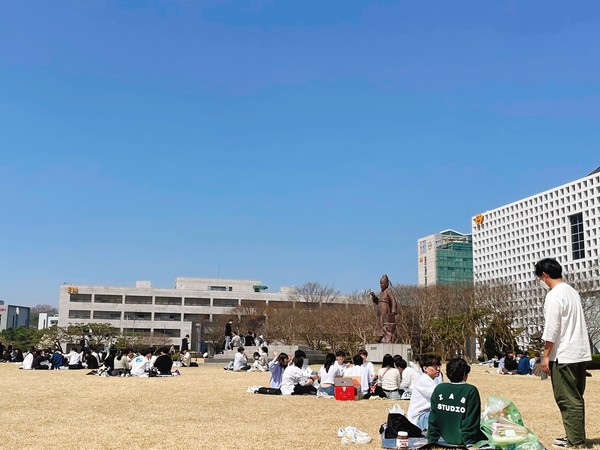The field is open, so’s that gate. I didn’t know they did that anymore. Who knew we owned this many photo spots? For years, I’ve roamed these empty aisles. Why have strawberries with no parties? Finally, they’re opening up the gates. There are actual real live people — it is totally strange. But wow, am I not ready for this change!
Early April is always the long-awaited period when cherry blossoms are in full bloom. For KAISTians, this is also the time for a campus tradition that began as early as 1995: strawberry parties. Under the blooming cherry blossoms, students sit on picnic mats in open fields to enjoy the warm spring weather with their friends as they chat, drink, and eat an assortment of picnic foods with strawberries and Nutella. While these outdoor parties — which almost always happen a week or two before the midterm week — were historically created to help local strawberry farmers, they now primarily serve as the last sanctuary of sanity and social interaction for the ever-stressed-out KAIST students. So big is their cultural and social significance, that many school organizations are facilitating the preservation of this tradition. The Student Welfare Committee builds booths that sell strawberries on-campus at an affordable price; labs and student clubs take a break from their busy schedules to host strawberry parties.

However, it turns out that burned-out students are not the only ones who are looking forward to this season. This time of the year is also notorious for the age-old issue of visitors coming on campus to enjoy the gorgeous spring view. KAIST campus, renowned for having beautiful cherry blossom trees all over, is apparently attractive enough to make its way to social media, blogs, and vlogs — spreading the news to an even wider audience. With hordes of over-ecstatic families, couples, and curious teenagers flocking to the same few social media-friendly spots, overcrowding, illegal parking, and littering are unfortunately inevitable.
Seeing large groups of people on campus is such a surreal experience after what felt like a neverending pandemic. While it is good to see the festive spring spirit back, the same cannot be said for the spring-specific problems. Beside not cleaning up after themselves properly after leaving the photo and picnic spots, visitors sometimes sneak into restricted buildings or dorms for many reasons — curiosity, urgent need to go to the restroom, or simple lack of awareness — raising privacy and security concerns. Where there are crowds, noise is also bound to happen; this is an especially serious issue during this pre-midterm exam period, when students need every last hint of concentration to grind before their exams. The sudden influx of visitors and their cars also block some of the main roads on campus, making it hard to move around and be on time for classes and appointments. The warm spring scene and the problems they bring seem to have picked up where they left off in 2019, as if the pandemic never happened. Aside from COVID-19-related concerns, the complaints raised by students during this transitory period are exactly the same as those from the pre-pandemic era.
For two years, we could temporarily put these problems aside. COVID-19 gave a valid reason for the university to close its gates to outsiders to control the spread of the virus. All entrances were tightly guarded, and everyone needed to show their IDs to get in. Some visitors did manage to break in, but their numbers were much less than those during “normal” years. In the spring of 2020 and 2021, students enjoyed a temporary semi-exclusive use of our campus’s coveted photo spots at the cost of large-scale strawberry parties. After the enforcement of the four-person-per-group limit in early 2021, the strawberry party atmosphere present in normal semesters seemed to have completely disappeared from the campus. The picnics migrated to video conference platforms, the vibrant cherry blossom and strawberry colors were present only as virtual backgrounds, and the “party” itself took place in solitary individual rooms. While unfortunate, this should have been the perfect opportunity to develop the necessary policies and facilities to mitigate the long-standing spring issues, as they did not need to be urgently dealt with back then. While the gates were closed, more litter bins could have been placed at strategic places, more parking spots could have been built, and stricter regulations could have been planned for both local campus members and visitors, to name a few. If we really could not wait to open the gates, shouldn’t this be the most logical first step to take?
It might be too late to think about the “should have been”s now that they are finally opening up the gates. Following Korea’s policy to return to normal, KAIST is slowly but surely removing the locks it has placed for two years. From the resumption of offline classes, in-person activities, and conferences, to the reopening of the Undergraduate Branch Library (N10), we seem to be given the idea that we are ready to coexist with COVID-19. Personally, I’m happy to get back a bit of the campus life I knew and see my juniors experience a more proper college life, but I don’t think we are completely prepared for this transition. On top of the new challenges posed by COVID-19, the same old problems we barely addressed over the past two years have come back to bite us. We might have missed offline strawberry parties too much to remember the visitor issues that always come with them, the same way we might have missed the group study rooms in libraries too much to remember how cumbersome it was to reserve them. The truth only dawns now when we are faced with them again after all these years. Perhaps the pandemic has helped us realize just how much we have ignored these issues — the question is, have we learned anything to solve them now?

